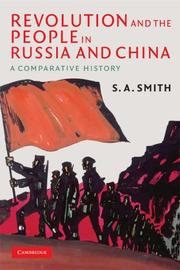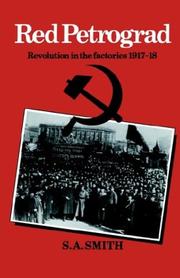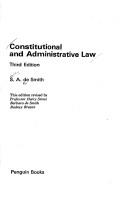| Listing 1 - 10 of 23 | << page >> |
Sort by
|

ISBN: 9780521713962 9780521886376 9781139167482 9780511396700 0511396708 9780511399053 0521886376 052171396X 1139167480 1107186781 1281383287 9786611383282 051139747X 0511398212 0511399057 0511395973 1316334686 Year: 2008 Publisher: Cambridge Cambridge University Press
Abstract | Keywords | Export | Availability | Bookmark
 Loading...
Loading...Choose an application
- Reference Manager
- EndNote
- RefWorks (Direct export to RefWorks)
A unique comparative account of the roots of Communist revolution in Russia and China. Steve Smith examines the changing social identities of peasants who settled in St Petersburg from the 1880s to 1917 and in Shanghai from the 1900s to the 1940s. Russia and China, though very different societies, were both dynastic empires with backward agrarian economies that suddenly experienced the impact of capitalist modernity. This book argues that far more happened to these migrants than simply being transformed from peasants into workers. It explores the migrants' identification with their native homes; how they acquired new understandings of themselves as individuals and new gender and national identities. It asks how these identity transformations fed into the wider political, social and cultural processes that culminated in the revolutionary crises in Russia and China, and how the Communist regimes that emerged viewed these transformations in the working classes they claimed to represent.
History of Eastern Europe --- History of Asia --- anno 1800-1999 --- Russian Federation --- China --- S06/0400 --- S06/0401 --- S06/0405 --- China: Politics and government--Communist Party and Communism: general --- China: Politics and government--Russia and Russian Communism (general works on Russia come here too) --- China: Politics and government--CCP, history and ideology: general --- Communism --- History. --- History --- Russia --- Bolshevism --- Communist movements --- Leninism --- Maoism --- Marxism --- Trotskyism --- Collectivism --- Totalitarianism --- Post-communism --- Socialism --- Village communities --- Arts and Humanities
Book
ISBN: 0814701183 9780814701188 Year: 1970 Publisher: New York : New York University Press,
Abstract | Keywords | Export | Availability | Bookmark
 Loading...
Loading...Choose an application
- Reference Manager
- EndNote
- RefWorks (Direct export to RefWorks)

ISBN: 0521316189 0521247594 113908545X 0511562950 Year: 1985 Publisher: Cambridge Cambridge University press
Abstract | Keywords | Export | Availability | Bookmark
 Loading...
Loading...Choose an application
- Reference Manager
- EndNote
- RefWorks (Direct export to RefWorks)
This book explores the impact of the 1917 Revolution on factory life in the Russian capital. It traces the attempts of workers to take control of their working lives from the February Revolution through to June 1918, when the Bolsheviks nationalised industry. Although not primarily concerned with the political developments of the Revolution, the book demonstrates that the sphere of industrial production was a crucial arena of political as well as economic conflict. Having discussed the structure and composition of the factory workforce in Petrograd prior to 1917 and the wages and conditions of workers under the old regime, Dr Smith shows how workers saw the overthrow of the autocracy as a signal to democratise factory life and to improve their lot. After examining the creation and activities of the factory committees, he analyses the relationship of different groups of workers to the new labour movement, and assesses the extent to which it functioned democratically.
arbeiders --- fabrieken --- revoluties --- vakbonden --- Rusland --- Arts and Humanities --- History --- Working class --- Factories --- Company unions --- History. --- Soviet Union --- Labor unions --- Factory buildings --- Industrial plants --- Manufacturing plants --- Mills (Buildings) --- Plants (Industrial buildings) --- Factory system --- Industrial buildings --- Mills and mill-work --- Workshops --- Commons (Social order) --- Labor and laboring classes --- Laboring class --- Labouring class --- Working classes --- Social classes --- Labor --- Employment --- Russia --- Rusland.
Book
ISBN: 9780198734826 0198734824 Year: 2017 Publisher: Oxford Oxford University Press
Abstract | Keywords | Export | Availability | Bookmark
 Loading...
Loading...Choose an application
- Reference Manager
- EndNote
- RefWorks (Direct export to RefWorks)
The Russian Revolution of 1917 transformed the face of the Russian empire, politically, economically, socially, and culturally, and also profoundly affected the course of world history for the rest of the twentieth century. Now, to mark the centenary of this epochal event, historian Steve Smith presents a panoramic account of the history of the Russian empire, from the last years of the nineteenth century, through the First World War and the revolutions of 1917 and the establishment of the Bolshevik regime, to the end of the 1920s, when Stalin simultaneously unleashed violent collectivization of agriculture and crash industrialization upon Russian society. Drawing on recent archivally-based scholarship, Russia in Revolution pays particular attention to the varying impact of the Revolution on the various groups that made up society: peasants, workers, non-Russian nationalities, the army, women and the family, young people, and the Church. In doing so, it provides a fresh way into the big, perennial questions about the Revolution and its consequences: why did the attempt by the tsarist government to implement political reform after the 1905 Revolution fail; why did the First World War bring about the collapse of the tsarist system; why did the attempt to create a democratic system after the February Revolution of 1917 not get off the ground; why did the Bolsheviks succeed in seizing and holding on to power; why did they come out victorious from a punishing civil war; why did the New Economic Policy they introduced in 1921 fail; and why did Stalin come out on top in the power struggle inside the Bolshevik party after Lenin's death in 1924. A final chapter then reflects on the larger significance of 1917 for the history of the twentieth century - and, for all its terrible flaws, what the promise of the Revolution might mean for us today.
Russia --- Soviet Union --- Russie --- URSS --- History --- Histoire --- History of Eastern Europe --- anno 1910-1919 --- anno 1900-1909 --- anno 1800-1899 --- anno 1920-1929 --- Russian Federation --- Russia - History - Nicholas II, 1894-1917 --- Soviet Union - History - Revolution, 1917-1921 --- Soviet Union - History - 1917-1936

ISBN: 0140802231 Year: 1973 Publisher: Harmondsworth
Abstract | Keywords | Export | Availability | Bookmark
 Loading...
Loading...Choose an application
- Reference Manager
- EndNote
- RefWorks (Direct export to RefWorks)
Administrative law --- Civil rights --- Justice, Administration of --- Constitutional law --- Droit administratif --- Droits de l'homme --- Justice --- Droit constitutionnel --- Administration --- -35 <41> --- 342.4 <41> --- -Civil rights --- -Justice, Administration of --- -Constitutional law --- 35 <41> Administratief recht. Bestuursrecht. Openbaar bestuur --(algemeen)--Verenigd Koninkrijk van Groot-Brittannië en Noord-Ierland --- Administratief recht. Bestuursrecht. Openbaar bestuur --(algemeen)--Verenigd Koninkrijk van Groot-Brittannië en Noord-Ierland --- Constitutional limitations --- Constitutionalism --- Constitutions --- Limitations, Constitutional --- Public law --- Administration of justice --- Law --- Courts --- Basic rights --- Civil liberties --- Constitutional rights --- Fundamental rights --- Rights, Civil --- Human rights --- Political persecution --- Law, Administrative --- Public administration --- 342.4 <41> Grondwet--Verenigd Koninkrijk van Groot-Brittannië en Noord-Ierland --- Grondwet--Verenigd Koninkrijk van Groot-Brittannië en Noord-Ierland --- Interpretation and construction --- Law and legislation --- Public law. Constitutional law --- Great Britain --- -Public law. Constitutional law
Book
Year: 1971 Publisher: Harmondsworth Penguin
Abstract | Keywords | Export | Availability | Bookmark
 Loading...
Loading...Choose an application
- Reference Manager
- EndNote
- RefWorks (Direct export to RefWorks)
Book
Year: 1960 Publisher: London
Abstract | Keywords | Export | Availability | Bookmark
 Loading...
Loading...Choose an application
- Reference Manager
- EndNote
- RefWorks (Direct export to RefWorks)
Book
Year: 1959 Publisher: London :New York, Oceana Publications : Stevens,
Abstract | Keywords | Export | Availability | Bookmark
 Loading...
Loading...Choose an application
- Reference Manager
- EndNote
- RefWorks (Direct export to RefWorks)
Book
Year: 1964 Publisher: London : Stevens,
Abstract | Keywords | Export | Availability | Bookmark
 Loading...
Loading...Choose an application
- Reference Manager
- EndNote
- RefWorks (Direct export to RefWorks)
Book
ISBN: 0191667528 0191756601 Year: 2014 Publisher: Oxford, England ; New York, New York : Oxford University Press,
Abstract | Keywords | Export | Availability | Bookmark
 Loading...
Loading...Choose an application
- Reference Manager
- EndNote
- RefWorks (Direct export to RefWorks)
Until the fall of the Soviet Union in 1991, historians knew relatively little about the secretive world of communist states and parties. Since then, the opening of state, party, and diplomatic archives of the former Eastern Bloc has released a flood of new documentation. The 35 essays in this handbook, written by an international team of scholars, draw on this new material to offer a global history of communism in the 20th century.
| Listing 1 - 10 of 23 | << page >> |
Sort by
|

 Search
Search Feedback
Feedback About UniCat
About UniCat  Help
Help News
News